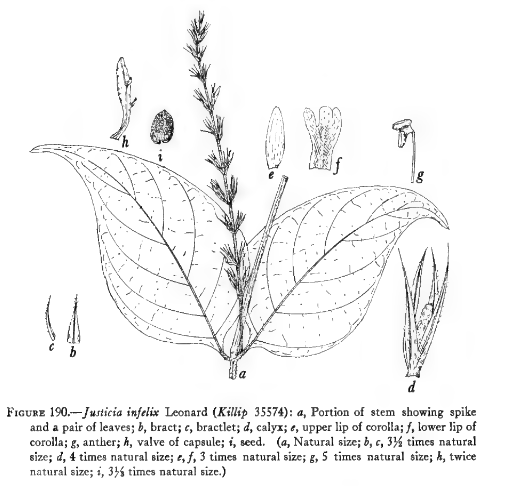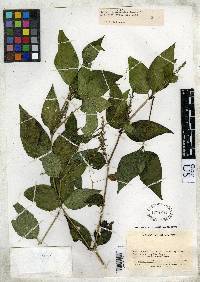
Neotropical Flora
|
Family: Acanthaceae
|
Herbaceous or suffrutescent plants up to 1 meter high; stems shallowly grooved, the lower portions terete, the upper subtetragonal, glabrous to moderately hirsute, the hairs more or less bifarious, curved, up to 0.57 mm. long; leaf blades ovate to oblong-ovate, up to 10 cm. long and 5 cm. wide, acute or short-acuminate (the tip itself blunt), acute to rounded at base and briefly decurrent on the petiole, moderately firm, entire, glabrous or the costa and lateral veins (4 or 5 pairs) rather obscure, more or less hirsute, the hairs curved, 0.28 to 0.38 mm. long, the cystoliths small and obscure; petioles 5 to 10 mm. long, glabrous to moderately hirsute; spikes terminal and axillary, 2 to 6 cm. long, 1 cm. broad, rather loose, the internodes up to 5 mm. long, the peduncles 1 to 1.5 cm. long, subquadrangular, glabrous to mod- erately hirsute with curved hairs 0.28 mm. to 0.38 mm. long, the rachis hirsute with curved hairs 0.28 mm. long; bracts ovate, 3.5 mm. long, 1.5 mm. wide at base, slenderly acuminate, glabrous or bearing toward the tip a few hairs 0.2 mm. long, the costa barely prominent; bractlets narrowly lanceolate, 3.5 mm. long, 0.5 mm. wide at base, gradually narrowed to a slender tip, carinate, sparingly hirsute dorsally with curved hairs about 0.2 mm. long, the costa not promi- nent; calyx 7.5 mm. long, the segments 4, lanceolate, about 7 mm. long, 0.75 mm. wide, sparingly hirsute dorsally, the costa prominent; corolla 10 mm. long with a pink lower lip, moderately hirtellous, the hairs spreading, about 0.2 mm, long, the tube 1.25 mm. broad at base, enlarged to 2 mm. at 2.5 mm. above base and narrowed to 1.25 mm. at middle, the throat 2.5 mm. broad, the upper lip ovate, 6 mm. long, 3 mm. wide at base, gradually narrowed to 1.25 mm. at tip, the tip itself truncate and shallowly emarginate, the lower lip cuneiform, 6 mm. long, 7 mm. wide at base of lobes, the lobes 3, ovate, 3 mm. long, the middle lobe 3.5 mm. wide, rounded and shallowly emarginate at tip, the lateral lobes 2 mm. wide, rounded, the lip swollen and plaited in throat of corolla; stamens exserted 2.5 mm. beyond mouth of corolla, the filaments flattened, glabrous toward tip, bearing a few hairs about 0.1 mm. long, the anther cells attached to a flat connective 0.5 mm. wide, slightly superposed, the upper cell 1 mm. long, horizontally attached, the lower one slightly shorter, vertically attached, sparingly hirtellous dorsally, the hairs about 0.11 mm. long; capsules 4-seeded, slenderly clavate, 1 cm. long, 4 mm. broad, 1.75 mm. thick, glabrate; retinacula 2 mm. long, slightly curved, the tip thin, obtuse; seed ovoid, 2.5 mm. long, 2 mm. broad, 1 mm. thick, truncate or obtuse at tip, obliquely cordate at base, dark blackish brown, verrucose. Type in the U. S. National Herbarium, No. 1772277, collected at Cisneros, in a thicket along the Río Dagua, Department El Valle, Colombia, 300 to 500 meters altitude, May 5, 1939, by E. P. Killip (No. 35574). Also of this species are Haught's No. 6383 (US), collected at an irrigation canal take-off along the Río Saldaña, Depart- ment of Tolima, altitude 400 meters, March 23, 1949, and Pérez- Arbeláez & Cuatrecasas' No. 6372 (US), collected in woods at the Hacienda Valparaiso, Zarzal, near Bugalagrande, Department El Valle, 1,020 meters altitude, July 20, 1939. Justicia infeliz is related to J. polygonoides H. B. K., but can be separated by its relatively broader leaf blades, broader bracts, larger calyces and corollas, and hirsute rachises. The specific epithet refers to the nondescript, weedy appearance of the plant. Haught's plant was a very slender undershrub, 40 cm, high, found growing on igneous rocks where water often overflowed; the flowers were purple with lighter lines. The color of the corolla of Killip's collection is not stated. |
Powered by Symbiota.





